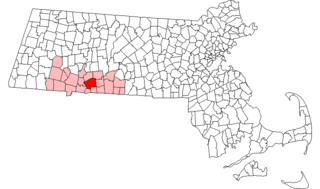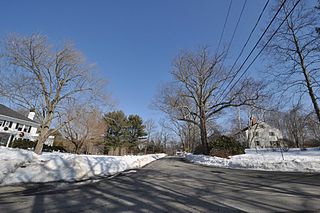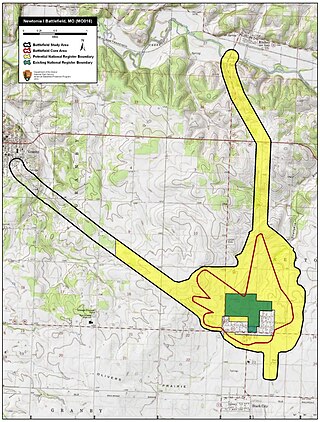
The National Register of Historic Places in the United States is a register including buildings, sites, structures, districts, and objects. The Register automatically includes all National Historic Landmarks as well as all historic areas administered by the U.S. National Park Service. Since its introduction in 1966, more than 90,000 separate listings have been added to the register.

This is a list of the National Register of Historic Places listings in Plymouth County, Massachusetts.
Uxbridge, Massachusetts has 53 sites on the National Register of Historic Places.

The Crane and Company Old Stone Mill Rag Room is one of the oldest surviving buildings of Crane & Co., one of the oldest papermaking businesses in Berkshire County, Massachusetts. It is located in southwestern Dalton, on a site where paper has been manufactured since the early 19th century. The building, originally used for processing rags, has housed the Crane Museum of Papermaking since 1930, and was designated a National Historic Landmark in 1983.

The Old Indian Cemetery or "Old Cemetery" is a historic cemetery at 50 Cottage Street in West Brookfield, Massachusetts.

The Wickaboag Valley Historic District is a predominantly rural historic district in West Brookfield, Massachusetts. It is roughly bounded by Wickaboag Pond, Mill Stone Rd., Madden Rd., and the border with New Braintree. The central feature of the district is two branches of Sucker Brook, which empties into Wickaboag Pond, and the rural views of the valley through which these streams move. Except for a cluster of houses near Wickaboag Valley, Shea, Ragged Hill, and Millstone Roads, buildings are sparsely arranged on the roads that pass through the district. There are fourteen houses of historic interest, the oldest of which date to the 1790s. There are also archaeological remnants of the area's early industrial history, with documented mill sites dating to the late 17th century.

The North Brookfield Town House is a historic municipal building at 185 N. Main Street in North Brookfield, Massachusetts. The 3+1⁄2-story wood-frame building was built in 1864 to a design by E. Boyden & Son. The building is located prominently in the center of North Brookfield's commercial district, and is distinguished by the 60-foot (18 m) tower at the corner of North Main and Summer Streets. The building is richly decorated with Italianate and French Second Empire styling. It is the town's third town hall.

The Forge Village Historic District of Westford, Massachusetts encompasses one of the town's historic 19th century mill villages. The focal point of the district is the mill complex of the Abbot Worsted Company, around which the village expanded after its founding in 1854. Prior to its founding the area was the site of a number of blacksmithies and iron forging operations, and was the site of a fulling mill in the 18th century. The center of the district is at the junction of East and West Prescott Streets with Pleasant Street, radiating away to ballfields on West Prescott, Abbot Street at Pleasant, and just beyond Orchard Street on East Prescott. Worker housing occupies a number of adjacent streets in the area.

This is a list of the National Register of Historic Places listings in Springfield, Massachusetts.

The Salem Cross Inn is a restaurant on a working farm at 260 West Main Street in West Brookfield, Massachusetts. It is located in the White Homestead, a c. 1740 Georgian style house built on the site of a c. 1707 house which now stands elsewhere on the property. The property has been listed twice on the National Register of Historic Places, in 1975 and 1978.

The Hall Memorial Library is the public library of Tilton and Northfield, New Hampshire. It is located at 18 Park Street in Northfield, in an 1887 Richardsonian Romanesque building. The building, one of the most architecturally distinguished in the region, was listed on the National Register of Historic Places in 1978.

The Robert C. Ingraham School is a historic school building at 80 Rivet Street in New Bedford, Massachusetts. The three story brick Romanesque Revival building was built in 1901 to a design by local architect Samuel C. Hunt, who designed several other New Bedford school buildings. It was built on a site previously owned by the Potomska Mill Company and used for mill worker housing, and was named for the first librarian of the New Bedford Free Public Library. The building served the city as an elementary school until 1977, and was used for storage until 1992. From 1992 until 2006 it housed a preschool.

The Manomet Mills are a historic textile mill complex on the north side of New Bedford, Massachusetts. They are located between Riverside Avenue and the Acushnet River, north of Manoment Street and the Whitman Mills. The complex consists of three Classical Revival brick buildings, built between 1903 and 1907. The main building, Mill No. 1, is a 54-bay three story structure that was built in 1903. It is attached to Mill No. 2 (1907), of similar size, by a single story brick structure. The third building is the Mill No. 2 Department Room (1907), a two-story brick building that was originally connected to the other two via overhead bridges, now removed. The mill complex was the main operating site of the Manoment Mill Company, which produced cotton yarn until about 1928. The buildings were sold in that year to the Delaware Rayon Company, which went bankrupt in 1954. Mill No. 2 was then used by the Acushnet Process Company for the manufacture of golf balls, while Mill No. 1 continued to be used for rayon production, a chemically intensive and environmentally hazardous process.

The Jewell Town District of South Hampton, New Hampshire, encompasses a colonial-era industrial village with a history dating to 1687. It is centered at the junction of West Whitehall and Jewell Streets, which is just south of a bend in the Powwow River, the source of the power for the mills that were built here. The area was settled in 1687 by Thomas Jewell, and by the early 19th century included a variety of mills as well as a bog iron works. The district now includes only remnants of its industrial past, and features a collection of 18th and early-19th century residential architecture. The district was listed on the National Register of Historic Places in 1983.

The Queensbury Mill is a historic mill building at 1 Market Street in Somersworth, New Hampshire. Built in 1884, it is unusual for the period for its wood-frame construction, and for its financing, executed by local businessmen to attract shoe manufacturers to the city. The mill was listed on the National Register of Historic Places in 1987. The building has been converted into apartments.
Jedediah Foster was a judge and advocate for independence during the American Revolution, and ultimately a justice of the Massachusetts Supreme Judicial Court.

Blackstone River Valley National Historical Park is a National Park Service unit in the states of Rhode Island and Massachusetts. The park was created for the purpose of preserving, protecting, and interpreting the industrial heritage of the Blackstone River Valley and the urban, rural, and agricultural landscape of that region. The Blackstone River Valley was the site of some of the earliest successful textile mills in the United States, and these mills contributed significantly to the earliest American Industrial Revolution. The subsequent construction of the Blackstone Canal, a few years after the successful completion of the Erie Canal, helped to sustain the region's industrial strength.

The First Battle of Newtonia Historic District, near Newtonia, Missouri, is a National Register of Historic Places (NRHP) site that preserves the location of the First Battle of Newtonia, an 1862 battle during the American Civil War. The battle saw Confederate troops under Colonels Douglas H. Cooper and Joseph O. Shelby defeat a Union force commanded by Brigadier General Frederick Salomon. The historic district contains some Civil War-period structures, as well as the Mathew H. Ritchey House, which is listed separately on the NRHP.

The Tobin's Beach Site is a prehistoric archaeological site in Brookfield, Massachusetts. Discovered in 1963, it is one of a small number of sites in New England known for preserving elements of the Adena culture. The site was declared eligible for listing on the National Register of Historic Places in 1986, and was formally listed in an enlarged state in 2018.

The Lucy Stone Home Site is a historic archeological site on Coy Hill Road in West Brookfield, Massachusetts. The site is owned and managed by The Trustees of Reservations, a non-profit land conservation and historic preservation organization, and is located within the Trustees' Rock House Reservation. The home site includes 61 acres (25 ha) of forested land on the side of Coys Hill west of West Brookfield village. Although the farmhouse in which Lucy Stone (1818-1893) was born and married burned to the ground in 1950, its ruins are at the center of the property. The site has long been a memorial to Stone, an early and prominent activist for women's rights.



















